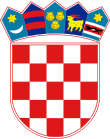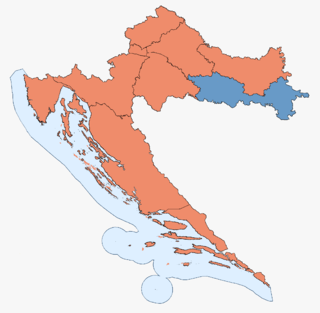- Croatian parliamentary election, 2000
-
Croatian parliamentary election, 2000 
1995 ← 3 January 2000 → 2003
membersAll 151 seats to Hrvatski sabor First party Second party 

Leader Ivica Račan Zlatko Mateša Party SDP HDZ Last election 24 seats, 18.9%
(SDP, HSLS, PGS, SBHS)75 seats, 59.06% Seats won 71
(SDP-led coalition)46 Seat change  47
47 29
29Popular vote 1,138,318 790,728 Percentage 38.7% 26.9% Third party Fourth party 

Leader Zlatko Tomčić Anto Đapić Party HSS HSP Last election 16 seats, 12.6%
(HSS, IDS, HNS, ASH)4 seats, 3.1%
(HSP, HKDU)Seats won 25
(HSS-led coalition)5
(HSP-led coalition)Seat change  9
9 1
1Popular vote 432,527 152,699 Percentage 14.7% 5.2%
Results of the election in each of the ten electoral districts of Croatia: the party with the majority of votes in each electoral unit.
SDP-HSLS coalition: red; HDZ: blue
Prime Minister before election
Subsequent Prime Minister
1992 election • MPs 1995 election • MPs 2000 election • MPs 2003 election • MPs Croatia 
This article is part of the series:
Politics and government of
CroatiaConstitutionJudiciaryExecutive- President (List)
- Ivo Josipović
- Government (List)
- Prime Minister
- Jadranka Kosor
- Cabinet
- Prime Minister
- Croatian Democratic Union (HDZ)
- Social Democratic Party (SDP)
- Croatian People's Party -
Liberal Democrats (HNS-LD) - Croatian Peasant Party (HSS)
- Istrian Democratic Assembly (IDS)
- Croatian Democratic Alliance
of Slavonia and Baranja (HDSSB) - Croatian Social Liberal Party (HSLS)
- Croatian Party of Pensioners (HSU)
- Croatian Party of Rights (HSP)
Divisions
Elections for the Chamber of Representatives of the Croatian Parliament were held on January 3, 2000. These were the first elections to be held after the expiration of a full term of the previous Chamber.
The ruling Croatian Democratic Union entered the elections weakened by the Zagreb Crisis, street protests and the series of corruption scandals that came to light in the previous parliamentary term. However, the most important factor was the deteriorating health of the party leader and Croatian president Franjo Tuđman, which sparked a succession struggle between various factions within the party.
On the other side, two major Croatian opposition parties - the Social Democratic Party of Croatia and Croatian Social Liberal Party - had their coalition formally agreed in 1998 and spent more than a year preparing for the elections. At first, they were to run together with the Croatian Peasant Party, Croatian People's Party, Istrian Democratic Assembly and Liberal Party, but as Tuđman's condition worsened leaders of the SDP and HSLS concluded that they could win elections even without those four other parties which later formed a separate bloc.
Like before all previous elections since the breakup of Yugoslavia, the electoral laws were altered in an attempt to improve the chances for the ruling party; this included a new voting system and redistricting. The First Past the Post constituencies introduced in the previous election were completely abandoned and Proportional Representation was implemented (with the exception of single representative ethnic minority seats). Croatia was divided into ten electoral districts, all drawn in order to maximise the support for HDZ. Each district had to elect 14 members, with candidates' lists having to win more than 5 % of the votes in order to be represented in the Sabor.
Due to Tuđman's illness and death, the actual date of elections had been repeatedly postponed for constitutional reasons. There were speculations about elections being held during the Christmas holidays in order to have as many Croatian expatriates (traditional HDZ supporters) in the country, but the date of January 3 was chosen as the most suitable. As the day of the elections approached, its outcome became more certain. The campaign was brief and relatively uneventful with the HDZ being visibly weakened and demoralised by the death of its long-term leader. On the actual day of elections the turnout - the biggest since 1990 - indicated the Croatian people's desire to have their government changed.
In the end, a coalition of SDP-HSLS, together with a bloc of four other parties, won a two-thirds majority allowing them to amend the Constitution and turn the Republic from a semi-presidential system to a parliamentary system. A few weeks later Ivica Račan became the new Croatian prime minister.
Summary of votes and seats
Summary of the 3 January 2000 Croatian Parliament (Hrvatski Sabor) election results Parties and coalitions Votes % Seats % Seat trend Seat change (%) Coalition: 1,138,318 38.70 Social Democratic Party (Socijaldemokratska partija Hrvatske) 43 28.48 
+20.7 Croatian Social Liberal Party (Hrvatska socijalno liberalna stranka) 25 16.56 
+7.11 Alliance of Primorje-Gorski Kotar (Primorsko goranski savez) 2 1.32 
+0.54 Slavonia-Baranja Croatian Party (Slavonsko-baranjska hrvatska stranka) 1 0.66 
-0.12 Croatian Democratic Union (Hrvatska demokratska zajednica) 790,728 26.88 46 30.46 
-28.60 Coalition: 432,527 14.70 Croatian Peasant Party (Hrvatska seljačka stranka) 17 11.26 
+3.39 Istrian Democratic Assembly (Istarski demokratski sabor/Dieta democratica Istriana) 4 2.65 
+0.31 Croatian People's Party (Hrvatska narodna stranka) 2 1.32 
-0.24 Liberal Party (Liberalna stranka) 2 1.32 
+1.32 Social Democratic Action of Croatia (Akcija socijaldemokrata Hrvatske) 0 0.00 
-0.78 Coalition: 152,699 5.19 Croatian Party of Rights (Hrvatska stranka prava) 4 2.65 
-0.50 Croatian Christian Democratic Union (Hrvatska kršćanska demokratska unija) 1 0.66 
+0.66 Serb People's Party (Srpska narodna stranka) 12,396 47.72 1 0.66 
+0.66 Non-partisans 3 1.99 Total 2,941,306 70.5% 151 100.00 Invalid Votes 50,340 Votes Cast 2,991,646 Registered Voters 4,244,578 Source: HIDRA[1], Adam Carr's Election Archive[2] Composition of Parliament
Government Opposition Government: SDP HSLS PGS SBHS HSS IDS HNS Liberal Minorities Opposition: HDZ HSP HKDU References
- ^ "Službeni rezultati izbora zastupnika za Zastupnički dom Hrvatskoga državnog sabora održanih 2. i 3. siječnja 2000.". Croatian Information-Documentation Referral Agency (HIDRA). http://hidran.hidra.hr/stranke/501rz2000.htm. Retrieved 2011-11-21.
- ^ State Electoral Commission. "Republic of Croatia - Legislative election of 3 January 2000". Adam Carr's Election Archive. http://psephos.adam-carr.net/countries/c/croatia/croatia2.txt.
Elections and referendums in Croatia As part of Austria-Hungary (1860s–1918)Kingdom of Croatia-Slavonia Kingdom of Dalmatia Modern Croatia (1990–present)Parliamentary elections Presidential elections Chamber of Counties elections Local elections Referendums (For the 1918–1989 period see Elections in Yugoslavia)Categories:- 2000 elections in Europe
- Elections in Croatia
- 2000 in Croatia
- President (List)
Wikimedia Foundation. 2010.


